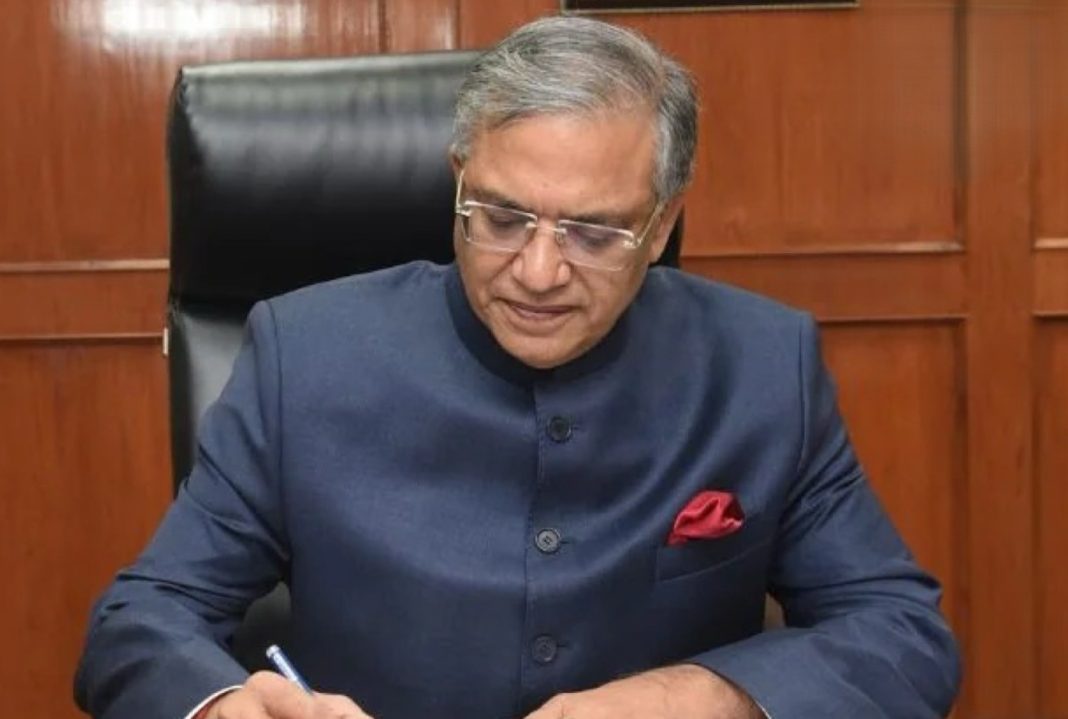By Satyabrat Borah
In a dramatic escalation of economic pressure on the Russian Federation, the United States has imposed sweeping sanctions on two of Russia’s largest oil producers, Lukoil and Rosneft, marking a pivotal shift in its strategy to compel an end to the protracted war in Ukraine. Announced by the Treasury Department on October 22, 2025, these measures target the state controlled Rosneft, headed by Vladimir Putin’s close ally Igor Sechin, and the privately owned Lukoil, which together account for nearly half of Russia’s seaborne crude oil exports. The sanctions blacklist the companies and more than three dozen subsidiaries, effectively prohibiting any transactions with them through the global financial system dominated by the US dollar. This move, described by Treasury Secretary Scott Bessent as a direct assault on the Kremlin’s war machine, aims to choke off revenues that fund Moscow’s military operations, which have ravaged Ukraine for over three and a half years.
The timing of these sanctions underscores a frustration within the Trump administration after months of diplomatic maneuvering yielded little progress. President Donald Trump, who entered office promising swift resolutions to international conflicts, had pursued direct talks with Putin, including a summit in Anchorage, Alaska, in August 2025. Those discussions faltered amid Russia’s refusal to commit to a ceasefire or meaningful peace process. A planned follow up meeting in Budapest was shelved just days before the sanctions were unveiled, with Trump citing Putin’s intransigence. In a statement, the White House emphasized that the blacklisting stems from Russia’s lack of serious engagement in negotiations, particularly after intensified bombardments that killed civilians in Kyiv and other cities on October 22. Ukrainian President Volodymyr Zelenskyy hailed the action as great news, noting it strikes at the heart of Moscow’s funding for aggression, while European allies, including the UK which imposed similar measures the previous week, signaled readiness to align.
India and China absorb approximately three quarters of Russia’s seaborne oil exports, a lifeline that emerged after Western sanctions in 2022 redirected flows from Europe to Asia. In September 2025 alone, India imported a record 2.07 million barrels per day of Russian crude, surpassing China’s 1.76 million, according to data from Vortexa and Kpler. Discounted prices, often below the G7’s 60 dollar per barrel cap, made Russian Urals and ESPO blends attractive for Indian refiners like Reliance Industries and state run entities, helping New Delhi manage its voracious energy demand amid economic growth. China, meanwhile, relies on pipeline deliveries less vulnerable to sanctions, but seaborne volumes from Rosneft and Lukoil have been crucial for its independent refiners in Shandong province.
The immediate fallout has been swift and telling. Chinese state giants PetroChina, Sinopec, and CNOOC suspended seaborne purchases from the sanctioned firms within hours, citing risks of secondary US penalties that could bar them from Western markets. Trade sources reported at least a short term hiatus in these imports, with refiners scrambling to source alternatives from the Middle East and Latin America. In India, where Reliance the nation’s top private buyer announced a recalibration of supplies, four tankers loaded with Russian crude idled off the western coast as buyers scrutinized paperwork to avoid direct ties to Rosneft or Lukoil. Nayara Energy, part owned by Rosneft and India’s second largest Russian oil importer, faces particular peril, with potential knock on effects for its exports already curtailed by EU restrictions. Indian officials, under pressure from Trump’s prior 25 percent tariffs on goods in retaliation for discounted Russian buys, indicated compliance would pave the way for eased trade barriers with Washington.
The world may navigate this disruption without catastrophe. Global oil markets reacted with a measured spike, Brent crude surging five percent to 64.91 dollars per barrel on October 23 before stabilizing, buoyed by ample spare capacity from OPEC plus nations like Saudi Arabia and the UAE. Analysts at Saxo Bank and UBS project that while Russian exports could dip by up to 2 million barrels daily in the coming months, non sanctioned Russian producers and rerouted shadow fleet tankers might mitigate losses. Russia, which has adeptly evaded prior curbs through obscure shipping and non dollar payments, could pivot to barter deals or increased sales to sympathetic buyers in Southeast Asia. Putin’s defiant response on October 23 dismissed the sanctions as an unfriendly act with limited bite, conceding only some losses but vowing never to bow. He warned of retaliatory measures, including threats against deeper US arms shipments to Ukraine like Tomahawk missiles, which Russian officials hyperbolically claim could spark World War III.
Complementing the US blacklist, Washington has intensified calls for the European Union to accelerate its divestment from Russian energy. In a September 2025 address to the UN General Assembly, Trump demanded an immediate halt to all EU purchases of Russian oil and gas, tying it to broader NATO commitments and potential sanctions relief. This pressure builds on the EU’s REPowerEU initiative, launched in 2022 and refined in a May 2025 roadmap that outlines a full phase out by January 2028. The bloc has slashed Russian oil imports by sea to near zero, but pipeline flows to landlocked Hungary and Slovakia persist at around 100,000 barrels daily via the Druzhba line, while gas constitutes 13 percent of supplies, mostly LNG routed through Turkey. EU Energy Commissioner Dan Jørgensen, during talks with US Secretary Chris Wright in Brussels, floated accelerating timelines to 2027 for LNG bans, but veto threats from Budapest and Bratislava highlight fissures.
These holdouts stem from energy security fears: Hungary’s reliance on Russian crude jumped to 86 percent in 2024, and Slovakia remains nearly fully dependent, arguing that abrupt cuts would spike prices and disrupt industries. Trump has framed this as a bargaining chip, withholding broader Russia sanctions until NATO allies comply, a stance that irks Brussels but aligns with his America First ethos. The EU’s October 23 response included fresh penalties on two Chinese refiners with 600,000 barrels per day capacity and Russia’s shadow fleet, signaling coordination with Washington. Ursula von der Leyen, the Commission President, affirmed the 2028 deadline but noted US pressure could hasten spot contract bans by end 2025. For Ukraine, whose grid has endured over 3,700 Russian drones and 1,370 glide bombs since mid October, these steps offer hope amid frontline stalemates in Donetsk and Kharkiv.
Broader geopolitical ripples extend beyond energy. The sanctions underscore Trump’s tactical pivot from his first term’s reluctance to penalize Russian business, driven by inflation worries that spiking prices could fuel domestic backlash. Now, with US shale output at record highs and LNG exports filling European voids, the administration bets on resilience. OPEC’s readiness to unwind cuts, as voiced by Kuwait’s oil minister, further cushions shocks. For Moscow, the hit to a sector funding a quarter of its budget could strain war efforts, especially with Ukrainian strikes on refineries already curbing output. Yet Russia’s economy, bolstered by wartime spending and Asian ties, shows adaptability; Putin floated concessions like returning deported children in reported peace feelers, but demands full Donetsk control as a precondition.
India and China, caught in the crossfire, exemplify the sanctions’ leverage. New Delhi, balancing ties with Moscow forged in Soviet era arms deals, risks US ire that could derail a nascent trade pact worth billions. Prime Minister Narendra Modi assured Trump of compliance during recent calls, eyeing diversified supplies from Guyana and Nigeria. Beijing, less vocal, prioritizes stability; its pipeline imports from Russia via Power of Siberia continue unabated, insulating core needs. Both nations’ refiners, facing higher freight and premiums for Middle Eastern grades, may pass costs to consumers, but experts like those at Kpler foresee no supply crunch thanks to floating storage and arbitrage opportunities.
As winter looms, with Ukraine bracing for blackouts from targeted strikes on regional facilities, these measures test global solidarity. Zelenskyy’s 12 point peace blueprint, circulating among allies and calling for prisoner swaps and child repatriation, clashes with Kremlin red lines on NATO expansion and Ukrainian neutrality. Trump, chairing a proposed peace board, envisions enforcement through economic sticks, urging allies to adhere. Putin’s October 20 rhetoric, reiterating demands for the Dnipro River as a defensive line, signals no retreat. Yet the oil blacklist’s success hinges on enforcement: will secondary sanctions deter evaders, or will Russia’s Phase Zero hybrid tactics, including drone incursions over Europe, escalate?
Markets’ poise reflects diversified sources and innovation, from US fracking to Gulf LNG. For the war weary, it’s a reminder that economics can bend geopolitics, pressuring Putin toward talks without igniting broader flames. As Trump quipped on October 24, if Putin underestimates the pain, so much the better. The path to Kyiv’s salvation may yet run through Moscow’s pump prices, proving that in 2025’s volatile world, blacklisting barrels could light the way to peace.




